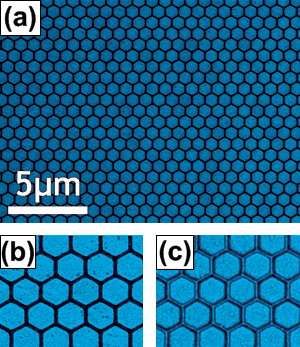Associate Professor John Cumings
Water, and its solid form, ice, are among the most ubiquitous materials on the surface of our planet. However, ice still carries many mysteries in its scientific understanding. For example, in its low temperature structure, the oxygen atoms show perfect crystalline order, but the hydrogen atoms (protons) are randomly arranged consistent with the so-called Bernal-Fowler rules. Briefly, these rules state that 1) two protons are strongly bound to each oxygen atom ("two in") and 2) each oxygen atom is weakly bound to two protons from neighboring water molecules ("two out"). Unexpectedly, this simple rule does not give a single simple structure. Instead, there is a vast manifold of low-energy configurations of protons that all obey the two-in two-out ice rule, and the structure will in general exhibit disorder. Unfortunately, this disorder is difficult to study directly, and many of the remaining mysteries of ice pertain to it.
In my group, we are trying to unlock some of these mysteries by studying a magnetic analog to ice, dubbed "artificial spin ice" [1]. In the artificial material, nanoscale NiFe ellipsoids behave like individual permanent bar magnets. To fabricate the artificial ice, I and my group members, Yi Qi, Todd Brintlinger, and Stephen Daunheimer use nanolithography to pattern the ellipsoids on a periodic lattice with the nearest-neighbors interacting at a common vertex. On the square lattice, the magnetic interactions influence the preferred magnetic configuration of nearest-neighbors to be two pointing in and two pointing out, showing the same basic ordering rules as ice. The difference is that now we can actually image the configurations directly using electron microscopy.

[Fig. 1. (a) A TEM image of the artificial spin ice created by the Cumings group. (b) a close-up image of a small region of the artificial spin ice. Each link is only 500 nm in length. (c) A Lorentz TEM image of the same region as (b). Here the magnetic direction can be determined by the bright and dark lines in each link. Despite showing disordered configurations, each vertex obeys the ice rule.]
We have recently obtained notable results by changing from the square lattice to the triangular kagome lattice (shown in Figure 1a, above). On the kagome lattice, the artificial ice is observed to perfectly obey its corresponding "ice rule" (two-in, one-out; or one-in, two-out). These results are recently published in 6 [2], and presented in lecture titled "Artificial Kagome Spin Ice" at the 2008 March Meeting of the American Physical Society. We are currently working to further understand the results through neutron scattering studies of larger arrays and by studying the effect of lattice imperfections, such as missing elements or lattice distortions. It is known that some types of lattice defects can remove the proton disorder from ice creating an ordered state, but little is known about why this occurs. In the near future, we hope to reproduce this ordering phenomenon in specially-modified artificial ice to learn why it occurs in real ice.
References:
[1] R. F. Wang, C. Nisoli, R. S. Freitas, J. Li, W. McConville, B. J. Cooley, M. S. Lund, N. Samarth, C. Leighton, V. H. Crespi, and P. Schiffer, ‚Artificial Spin Ice‚ Nature, 439, 303 (2006).
[2] Yi Qi, T. Brintlinger, and John Cumings, Direct observation of the ice rule in artificial kagome spin ice, Physical Review B, 77, 094418 (2008). Abstract and Paper
Top